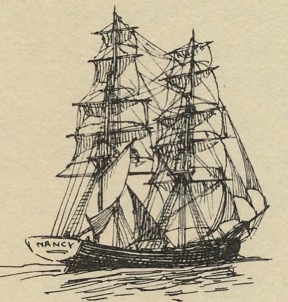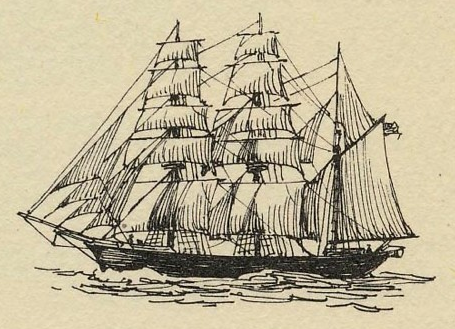| Barge | A boat of a long, slight and spacious construction. |
| Barque (Bark) | A sailing vessel with three masts, square-rigged on the fore and main and with only fore-and-aft sails on her mizzen mast. |
| Boat | Any small open craft without decking and propelled by oars, sometimes assisted by a small lugsail on a short mast. |
| Brig | A two-masted square-rigged vessel, a brigantine. |
| Clipper | A three-masted vessel used to transport tea, silks and spices from the East. The ships were named clippers because their speed could “clip” the time of a formerly long journey. |
| Cutter | A one-masted vessel rigged with a gaff mainsail, topsail, headsails and usually a square topsail. The name is derived from their fast sailing. |
| East Indiaman | The name given to the ships of the various East India companies. Ships of these companies were highly gilded and decorated with carving and were often well furnished. Always well armed as warships. The English and Dutch companies built and serviced their own ships and maintained them in their own private dockyards. |
| Fireship | Specialized vessel converted or built for the purpose of attacking moored or disabled vessels. |
| Frigate | (1) A large sloopof 16 or 18 guns, or (2) Any small cruising warship. |
| Gig | A light, narrow ship’s boat, built for speed. |
| Hospital Ship | An old warship or merchantman converted to serve as a floating hospital, usually to accompany a fleet or to be moored as a hulk [Not purpose-built during this period]. |
| Hoy | A small single-masted sailing cargo vessel – used as a dockyard craft. |
| Hulk | A dismasted ship, usually old and past active service, used as a receiving ship, sheer hulk, hospital or accommodation ship, or stationary storeship. |
| Jollyboat | A small ship’s boat, used for a variety of purposes. It was clinker-built, propelled by oars, and was normally hoisted on a davit at the stern of the ship. |
| Ketch | A vessel fitted with two masts (i.e., the main and mizzen masts). |
| Lazarette (or Lazaretto) | A hulk used as accommodation for seamen undergoing quarantine (to prevent or limit the spread of plague and other infectious diseases between ship and shore). |
| Lighter | A large, open, flat-bottomed boat, with heavy bearings, employed to carry goods to and from ships. |
| Longboat | The largest ship’s boat. |
| Lugger | A small vessel with four-cornered cut sails, set fore-and-aft, and may have two or three masts. |
| Lump | A short, heavy lighter used in Dockyards for carrying anchors, chains and heavy stores to and from ships. |
| Packet | A small vessel usually employed to carry mails between ports |
| Pinnace | A type of ship’s boat which was rowed with eight oars (later increased in length to take sixteen oars). |
| Powder hulk | A vessel for storing and issuing gunpowder – preferably moored at a safe distance from the dockyard to which it was attached. |
| Privateer | An armed merchant ship, licensed by a letter of marquee to cruise against enemy ships to her owners’ profit. |
| Prize | Name used to describe an enemy vessel captured at sea by a ship of war or a privateer. The word is also used to describe a contraband cargo taken from a merchant vessel and condemned in an Admiralty Court. |
| Schooner | A small vessel rigged with fore-and-aft sails on her two or more masts; largely used in the coasting trade – they required a smaller crew than a square-rigged vessel of comparable size. |
| Sheer hulk | A vessel fitted with a pair of “sheer legs” (two large spars formed into an “A frame”) to hoist masts in and out of vessels; in effect, a “floating crane”. |
| Ship | From the Old English scip, the generic name for sea-going vessels (as opposed to boats). Originally ships were personified as masculine but by the sixteenth century almost universally expressed as feminine. In strict maritime usage, signified a vessel square-rigged on three masts. |
| Ship of the line | A line-of-battle ship. |
| Sloop | A small man-of-war, rigged as a ship, brig or ketch. |
| Smack | A small fore and aft rigged single masted coastal craft. |
| Snow | A small square-rigged vessel (similar to a brig) with a supplementary trysail mast. |
| Storeship | A ship intended to carry naval stores (spars, timber cordage, tar, etc. – all the material needed to repair naval warships). In contrast, a transport was intended to carry men. Storeshipswere auxiliary vessels with a small defensive armament. Most were converted from merchantmen, though in some instances they were purpose-built or converted from first-line fighting vessels of different types. |
| Tank vessel | Dockyard craft fitted with iron tanks and pumps to provide water to ships in harbor. |
| Tender | A vessel employed to assist or serve another, an auxiliary vessel. |
| Transport | A cargo vessel engaged by the government to convey troops, convicts, or stores (invariably these were chartered merchantmen – the Navy owned and manned only a small number). |
| Troopship | A ship converted to carry troops. It could be a regular warship or a converted merchantman. |
| Whaleboat | The name given to an open boat, pointed at both ends so that it was convenient for beaching either on the bow end or the stern. Used under oars, and had to rudder – steered by an oar over the stern. The whaling ship, according to its size, carried as many as six or eight whaleboats. |
| Whaler | The name used for the vessel, with its complement of whaleboats, which sailed to catch whales with hand-thrown harpoons. |
| Wherry | A light rowing boat used chiefly on rivers for the carriage of passengers and goods; also a shallow single sail boat indigenous to the Norfolk broads (East Anglia). |





